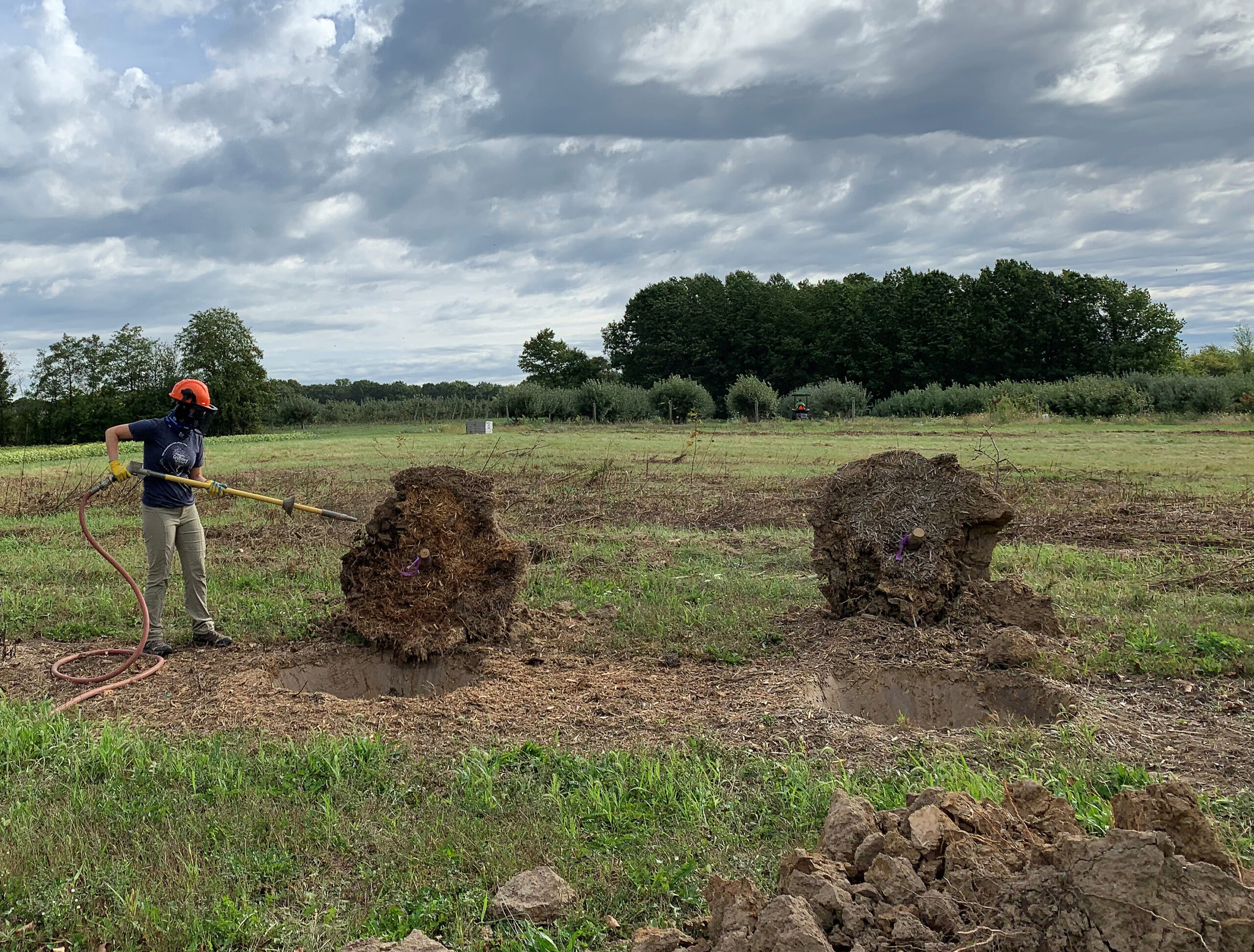Container-grown trees seem to be everywhere—but as anyone that has planted one can attest, the root systems of such plants often are a circling, matted, tangled mess. Over the past 12 years, Bert Cregg’s lab at Michigan State University has investigated the physiology of improving establishment of container-grown trees. In what follows, Dr. Cregg will explain the genesis of this program and the initial trials, which focused on one treatment applied to a single cultivar, and research technician Riley Johnson will discuss research she undertook for her master’s thesis, expanding the lab’s trial program to other species and treatments.
Why do nurseries want to produce trees in containers? Growing trees in plastic containers filled with lightweight media—made up primarily of pine bark or Douglas-fir bark—provides advantages to nursery producers because container production uses space more efficiently than field-production and eliminates the loss of soil each time a balled-and-burlapped (B&B) tree leaves the farm. Container growing also increases tree growth and allows growers to turn trees over faster in the nursery. It also eliminates the loss of tree roots that occurs in digging balled-and-burlapped (B&B) trees, occurrence of which can go as high as 90 percent, according to a study by Watson and Himelick (1982). More importantly, container trees weigh much less than similar-sized B&B trees, often eliminating the need for heavy equipment to handle trees on a planting site.

As soon as we remove the container, however, the downside to container-grown trees becomes apparent: circling roots. As soon as a tree is planted in a container at the nursery, its roots begin to grow outward. Encountering the sidewall, the roots deflect sideways and begin to follow the contour of the container. As the roots continue to develop, they lignify, putting on wood, and thus these circling roots become a permanent root deformity. If circling roots are not corrected when the tree is planted, they can have several negative consequences; they limit the amount of root egress outward into the surrounding backfill, which slows tree establishment and reduces tree stability (Gliman and Masters, 2010; Gilman et al., 2010), and they ultimately contribute to stem-girdling roots, which can reduce vigor and even threaten tree survival (Johnson and Hauer, 2000).
Horticulturists have been dealing with the question of what to do about circling roots for nearly as long as nurseries have been growing trees in containers. Over the years, researchers and practitioners have tried a range of methods to mitigate circling roots on container-grown trees and shrubs, including teasing (physically disentangling roots), slicing or scoring (making a series of vertical slits in the root system to disrupt the circling roots), and butterflying (making one or two slices through the bottom of the root system and splaying out the ends). As often happens in arboriculture, research trials on mitigating circling roots yielded mixed results, and there was not a clear consensus on the best approach. In the early 2000s, Dr. Ed Gilman and his research group at the University of Florida conducted a series of trials on pruning roots of container-grown trees. In particular, they focused on “shaving” root systems—that is, using a saw or sharp spade to remove the outer periphery of roots from the rootball and the “pancake” mass of roots that typically forms in the bottom of the container. A key finding from these trials is that shaving root systems not only reduced circling roots but stimulated new outward root growth that improved tree stability—a key and important consideration in hurricane-prone Florida. However, as a tree physiologist, my immediate concern is the potential of root shaving to increase transplant stress on trees—not to mention stress on propagators (for those who have never done it, root shaving is not for the faint of heart). Shaving removes a lot of roots, many of them fine roots that perform the critical functions of water and nutrient uptake. In our trials we’ve removed up to one-third of the total root biomass—though the proportion of fine roots removed is even higher, since they are concentrated in the outer portion of the root system that we’re shaving off.
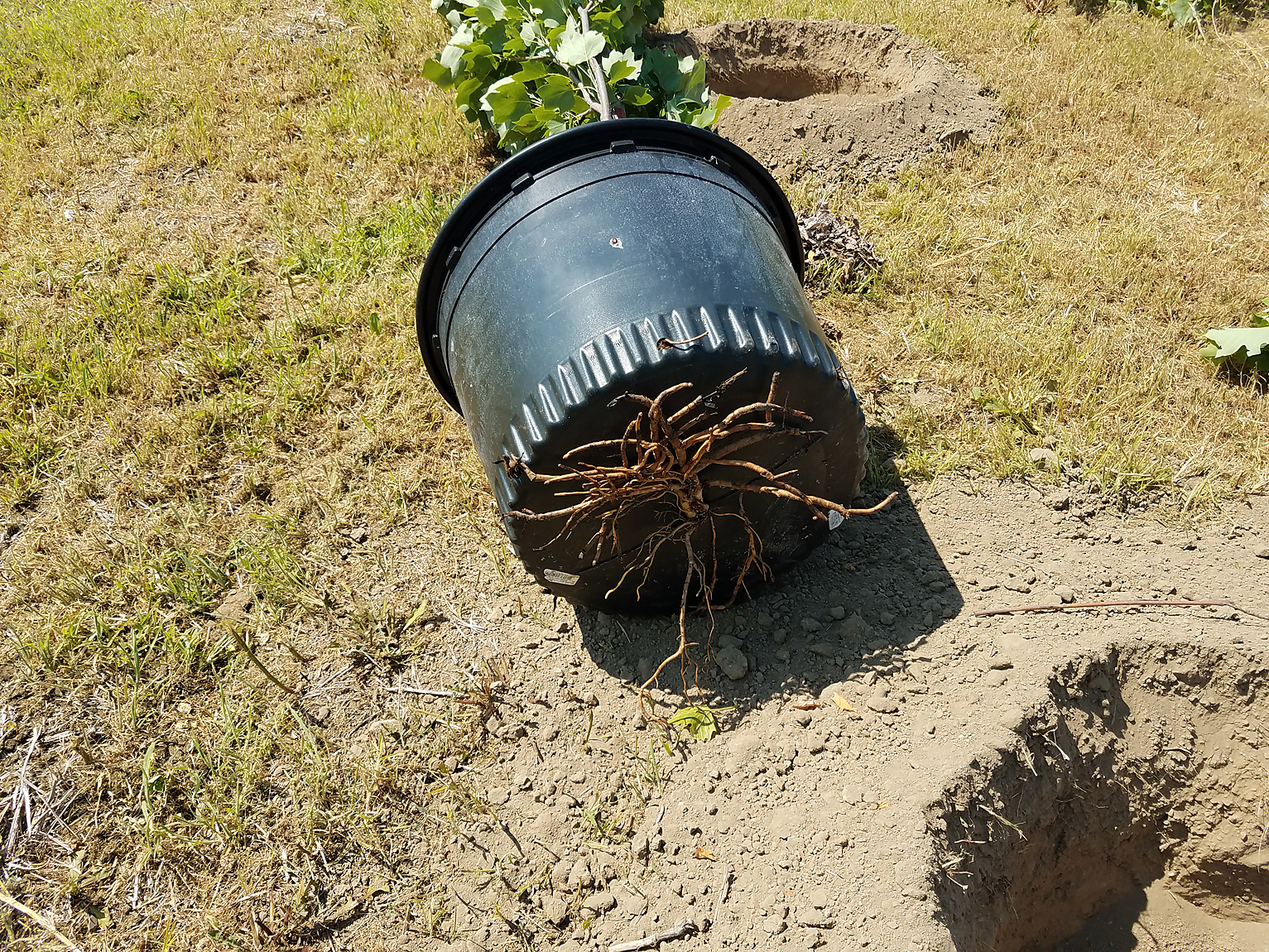
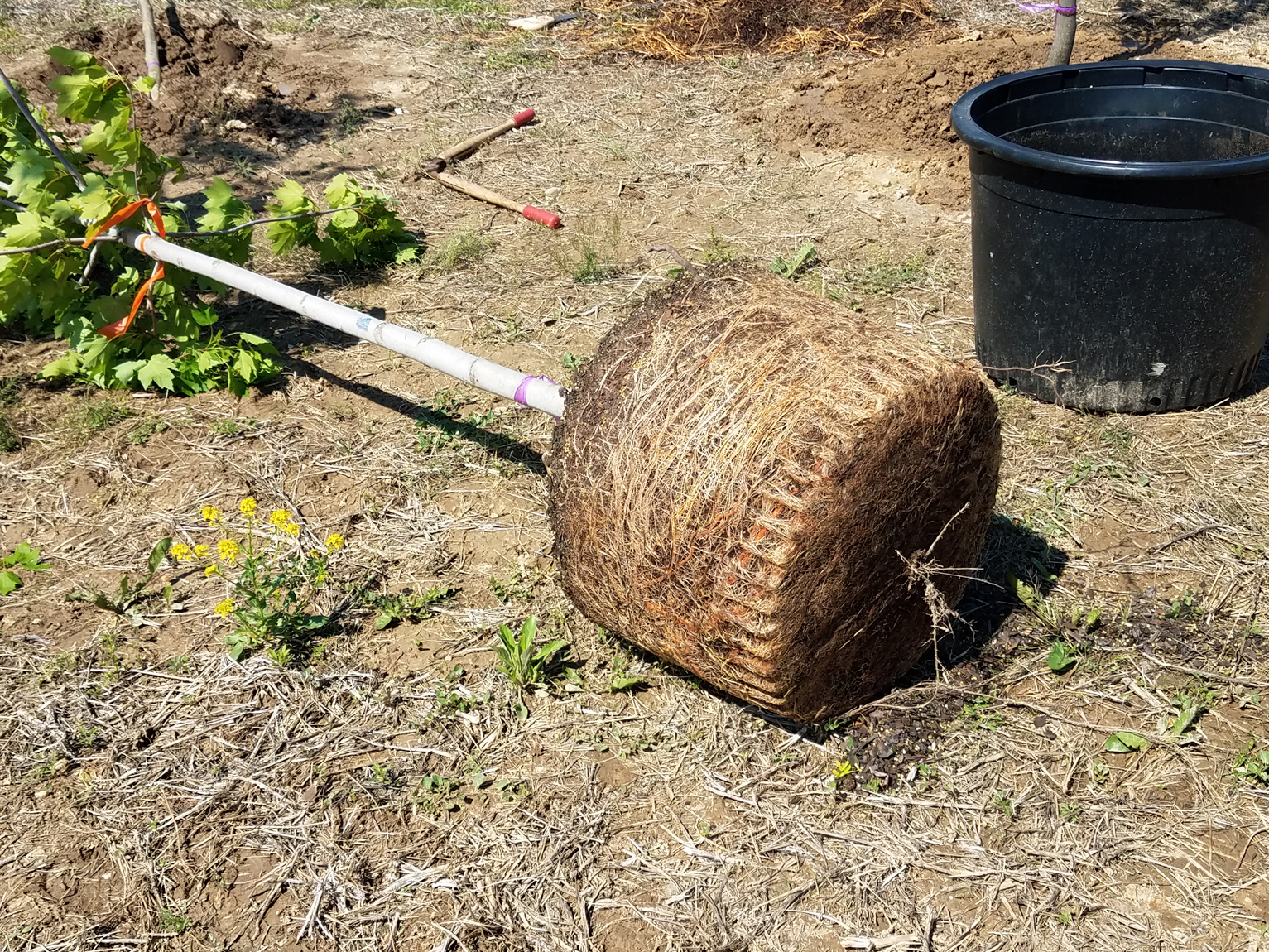

Starting in 2012, my lab began a series of trials aimed at the question of mitigating circling roots and tree stress. We had over 100 ‘Bloodgood’ London planetrees (Platanus . acerifolia) in 25-gallon containers in our pot-in-pot nursery at the MSU Horticulture Teaching and Research Center (HTRC). The trees had been grown in the containers for two years, had plenty of circling roots, and were prime candidates for a trial. I knew I wanted to look at shaving, but wanted to consider other factors as well. These first trials trace back to my involvement with the Garden Professors Blog, whose avid readership offered a wide array of horticultural expertise and curiosity. I polled the blog readers, who selected two evergreen questions: the effect of fertilization at planting and at mulching. Based on this information, we installed two trials in spring 2012.
Horticulturists have been dealing with the question of what to do about circling roots for nearly as long as nurseries have been growing trees in containers.
The first trial was installed as a combination of three root treatments (shaving, teasing, and untreated control) and two fertilizer treatments (with and without). For the shaving treatment, we removed the outer one inch of roots around the periphery of the root systems with a pruning saw. For the teasing treatment, we disentangled the roots with a garden fork. The fertilizer treatment was an addition of 400 grams of controlled-release fertilizer, which is what the trees received each year when we grew them in the nursery. We tracked growth of the trees for two years and then dug up a subsample of trees with a 48-inch tree spade and cleaned the soil from the roots with an air spade. Fertilization at planting did not impact tree diameter or height, which is consistent with many studies (Day and Harris, 2007; Harris et al., 2008). As we began to unveil the root systems, however, the root-treatment effects were immediately apparent. The imprint of the original plastic container was evident on all the control trees, whereas the trees that had been teased or shaved clearly had fewer residual circling roots and had more outward root growth. We quantified the amount of root egress by trimming and collecting the roots that extended beyond the container, which were then dried and weighed. These data confirmed our visual observation, with shaved roots yielding the most growth, followed by the teased roots, with the control plants exhibiting the lowest yield. In the second part of the 2012 trial, we repeated the root treatments (shave, tease, and control) and crossed these with two mulch treatments (with and without 3 inches of ground pine bark). After four years of observing the trees in the landscape, we again measured tree growth and excavated the root systems. In this case, mulching dramatically increased stem caliper growth (35 percent larger than non-mulched) and height growth (55 percent taller than non-mulched), and shaving and teasing were effective at eliminating circling roots and improving root egress. In this trial, we also measured leaf water potential (a measure of the amount of tension of the water in the tree’s xylem tissue, which helps us track plant moisture stress) and found there was no difference in stress for trees that were shaved versus the other treatments (Cregg and Ellison, 2018). In other words, my initial fear, that the root removal associated with shaving would increase transplant stress, was ill-founded. For the planetrees in our trial, at least, shaving was emerging as the most hopeful option.
Different species varied widely in their response to the same root treatments.

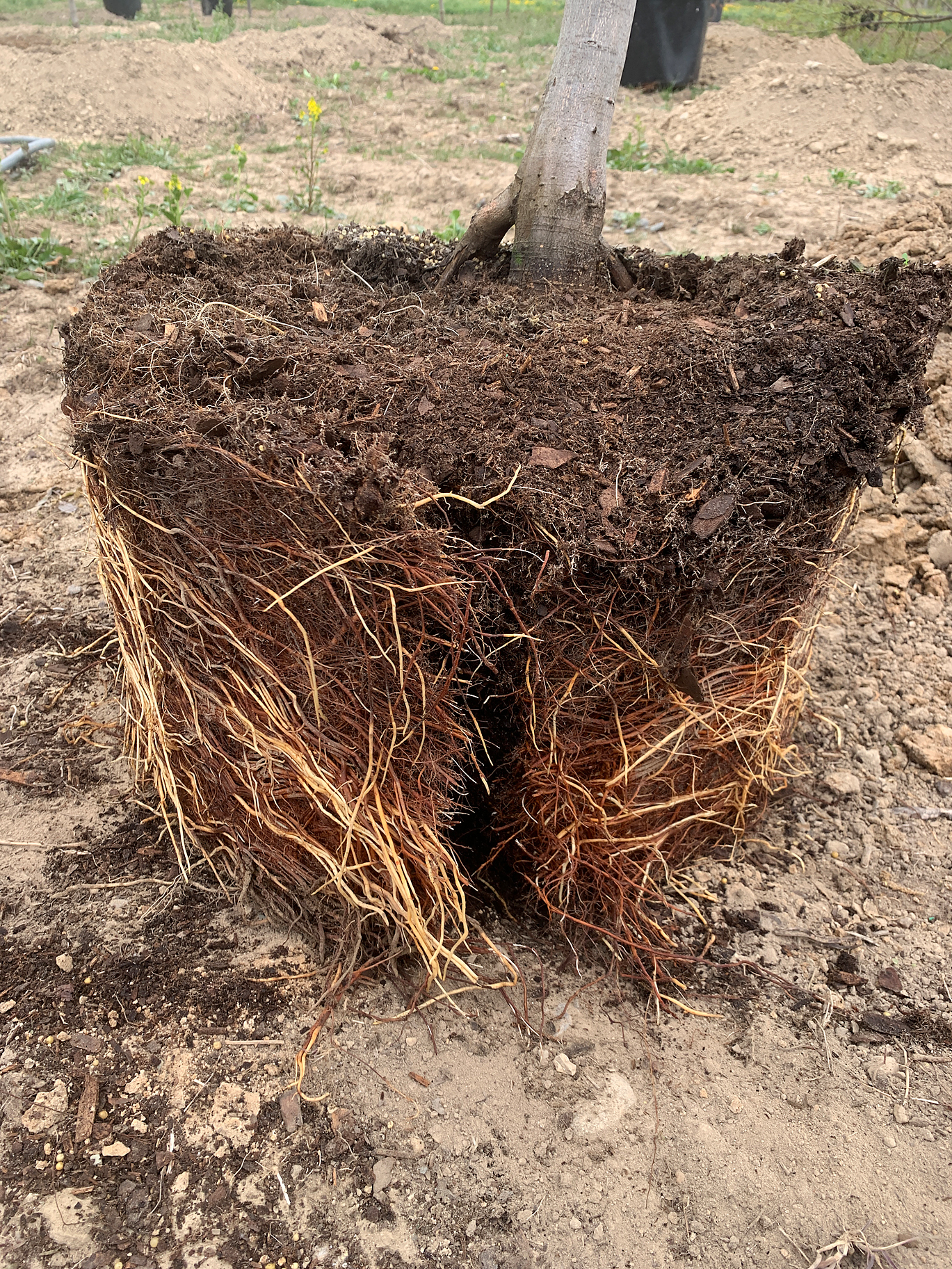
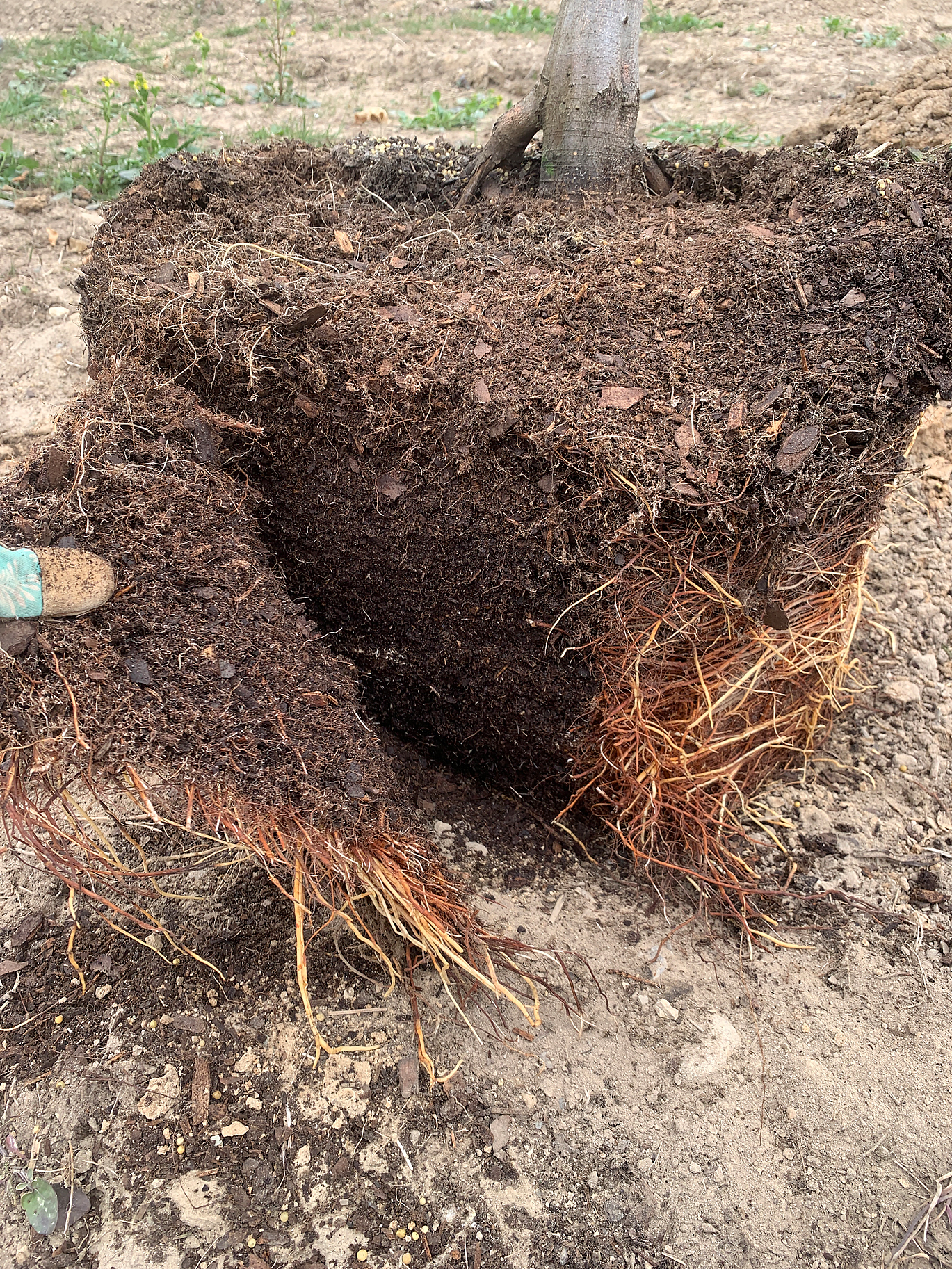

For the 2018 trial, we wanted to continue evaluating root shaving by trialing the technique with additional species; along with the ‘Bloodgood’ London planetrees, we also included two other commonly used landscape trees: ‘October Glory’ red maples (Acer rubrum) and columnar tulip trees (Liriodendron tulipifera). Another root-modification technique being touted by some industry professionals was “bare-rooting” or “root washing,” in which all of the container substrate or soil around and within the tree’s root system is removed in order to correct any root defects by pruning them out. Claims of the benefits of these techniques were anecdotal and somewhat controversial (Chalker-Scott, 2020; Cappiello, 2020), and so we chose to include these treatments in our study, too.
With our experimental design, we were able to compare trees across four root treatments: (1) untreated control, (2) root shaving, (3) bare-rooting using water (i.e., “washing” the root systems with a garden hose to remove the substrate, then pruning out any malformed or circling roots), and (4) bare-rooting using compressed air (i.e., blasting away the container substrate using an air spade, then pruning out any malformed or circling roots). We planted all of the trees at the HTRC, evaluated their growth and stress responses, and dug them up after two years. This time, we were able to note how different species varied widely in their response to the same root treatments. Like in the previous trial, leaf water-potential values of London planetrees did not vary across root treatments except for the measurements immediately following planting, and this was the same for the red maples, suggesting they are resilient to root pruning. When measuring the tulip trees, however, we found that the water-potential values among the bare-rooted trees remained low compared to the other root treatment groups, and this ultimately preceded doom for several tulip trees. We also observed a significant amount of leaf scorch and stem dieback among the trees in the bare-root treatments, indicating that the trees were attempting to regain a functional equilibrium and balance the plant’s root-to-shoot ratio to minimize critical water loss/difficulty with water uptake (Rouse, 2021).
Bare-rooting via either method did improve the tree root system quality—of those that survived. There was significant mortality among the tulip trees that were bare-rooted, whereas all of the London planetrees across all root treatments survived, and a few red maples died (including a control tree). Shaving reduced circling roots for planetrees and tulip trees, but shaving did not benefit the dense, fibrous root systems of the red maples. This is why having additional species included in these trials is critical: we cannot generalize how best to care for trees when we know that species will respond differently to any variable.
Most recently, in 2021, we initiated a new study to continue building on our knowledge of these root modification techniques. To better categorize our recommendations around root modification, we chose to use species that are known to be “difficult to transplant” as bareroot planting stock. These species include ‘Emerald City’ tulip tree (unsurprising given our earlier observations), American hornbeam (Carpinus caroliniana), and American hophornbeam (Ostrya virginiana). We also included the ‘Bloodgood’ London planetree as positive control due to the resilience to all root-modification treatments they displayed in previous experiments; London planetrees also are often described as an easy-to-transplant bareroot species. Root treatments for the 2021 trial included: (1) untreated control, (2) deep scoring (vertical slices made using a pruning saw to sever outer circling roots), (3) root shaving, and (4) bare-rooting using water. Additionally, because trees that we bare-rooted in 2018 exhibited such extreme leaf scorch following planting, we also tried compensatory pruning, preemptively reducing crown size to increase the root-to-shoot ratio of a subset of trees in the bare-root and control groups. Averaged across all species, compensatory pruning reduced the amount of crown dieback of those trees that were bare-rooted, but pruning made no difference where roots were left untreated. Compensatory pruning is not a recommended practice in arboriculture; however, our preliminary findings indicate that the practice may be useful to balance the root-to-shoot ratio when removing a substantial amount of root biomass as in bare-rooting.
The trees from the 2021 planting are still in the landscape at the HTRC, and we have been monitoring their growth and physiological responses over the past three years. Thus far, bare-rooting has again been noted as extremely stressful for the “difficult-to-transplant” species. Like the pattern noticed previously, many of the bare-rooted trees (other than the planetrees) underwent critical levels of moisture stress following transplanting, and ultimately died early in the first growing season. In spring 2024, we plan to begin our tree excavation to evaluate the roots systems and determine if any of the initial treatments decreased root circling caused by the initial nursery containers.
After a decade of research aimed at mitigating circling roots, root shaving has consistently improved root egress and root system quality without having detrimental impacts on tree physiology and growth. In the nursery trade, advancements to the standard plastic nursery container have been made to greatly reduce circling roots, yet in some areas, these alternative container designs have been slow to come to market. Many nursery growers are becoming more conscious of the need to produce higher quality root systems to promote longevity of their trees post-transplant, so they are taking the time and care to root-prune or shave root systems when up-potting their trees, leading to fewer container imprints.
References
Cappiello P. 2020. A closer look at root washing. Fine Gardening 195:16–17.
Cregg, B., & Ellison, D. 2018. Growth and establishment of container-grown London planetrees in response to mulch, root-ball treatment and fertilization. Urban Forestry & Urban Greening, 35, 139–147.
Day, S. D., & Harris, J. R. 2007. Fertilization of red maple (Acer rubrum) and littleleaf linden (Tilia cordata) trees at recommended rates does not aid tree establishment. Arboriculture and Urban Forestry, 33(2), 113.
Gilman, E. F., & Masters, F. J. 2010. Effect of tree size, root pruning, and production method on root growth and lateral stability of Quercus virginiana. Journal of Arboriculture, 36(6), 281.
Gilman, E. F., Paz, M., & Harchick, C. 2010. Root ball shaving improves root systems on seven tree species in containers. Journal of Environmental Horticulture, 28(1), 13–18.
Harris, J. R., Day, S. D., & Kane, B. 2008. Nitrogen fertilization during planting and establishment of the urban forest: a collection of five studies. Urban Forestry & Urban Greening, 7(3), 195–206.
Johnson, G., & Hauer, R. 2000. A practitioner’s guide to stem girdling roots of trees. University of Minnesota Extension Publication BU-7501-S.
Rouse, R. P., & Cregg, B. 2021. Species and season affect response of container-grown shade trees to pre-plant root modifications. Urban Forestry & Urban Greening, 63, 127184.
Bert Cregg is a professor of horticulture and forestry at Michigan State University (MSU). He conducts research on the physiology and management of trees. Riley Johnson is a research technician in the Department of Horticulture at MSU, where she manages tree planting experiments.
